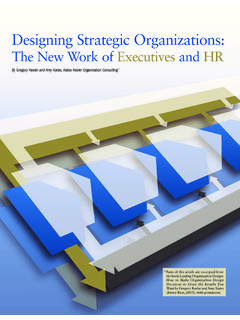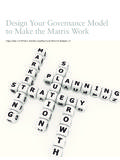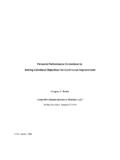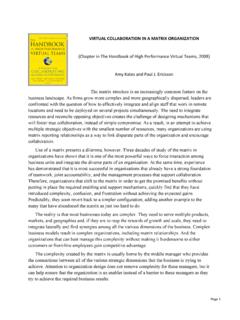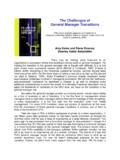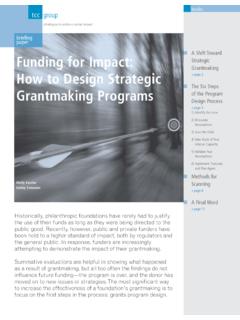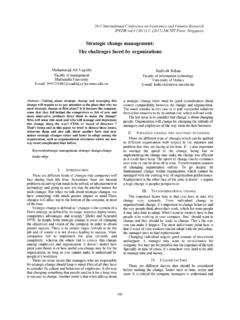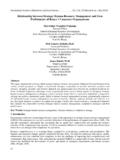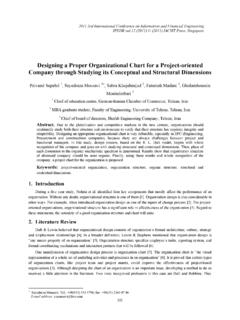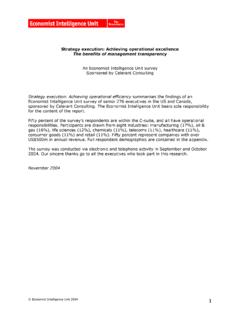Transcription of (Re)Designing the HR Organization - Amy Kates
1 22 HUMAN RESOURCE PLANNING HR functionshave gonethrough theprocess of transformation over the pastdecade. This redefinition of thework of HR is intended to allowa more strategic focus on talentmanagement and organizationalcapability while systematizingand controlling the cost oftransactional work. Little formalconsideration has been given,however, to how these newcomplex HR organizationsshould be configured to bestachieve these goals. This arti-cle highlights the operationalchallenges created by the mostcommon Organization designused by HR departments thebusiness partner model andpresents an emerging model the solutions center that isintended to address theseflaws. Each model is describedand discussed and a set ofconsiderations for the HRleader is offered in order tomaximize the effectiveness ofthe chosen Kates , Downey Kates Associates (Re)Designing theHR OrganizationOver the last decade there has been a profound shift in the work ofthe HR function.
2 The publication in 1997 of David Ulrich s HumanResource Championsspurred HR leaders across various industries torealign their organizations in order to undertake strategic businesspartner work. At the same time, a focus on cost-cutting and efficien-cy aimed at staff functions in general and at HR in particular haspushed much HR transactional work into shared services or to out-sourced many HR departments, this process of transformation, as itis popularly called, has been a wrenching experience. It has requiredrethinking the fundamental role of the HR function and shifting thedefinition of the HR customer from the traditional focus on theemployee to an almost total focus on the management ranks. The goalhas been to create an Organization that can deliver the necessary, daily(but low value-added) transactional work of HR consistently and efficiently while at the same time undertaking complex consulting and project-based work that is intended to further strategic companies are still in the midst of this process, and it will bea number of years before we know if these changes will have paid offfor the organizations they support.
3 In the meantime, much attentionhas been paid to redefining the new work of HR. However, althoughmost human resource departments have been through one or moremajor restructurings in the past 10 years, less consideration has beengiven to how to best configure these new HR article highlights the challenges created by the most commonorganization design currently used by HR departments and presentsan emerging model that is intended to address these flaws. The articleconcludes with a set of considerations for the human resource leaderin order to make their chosen Organization design model more a Focus on Organization Design?The demands on the human resources function have never beengreater. Since 1970, the world s 50 biggest companies have tripled in size, and the number of consumer products introduced each yearhas increased 16-fold (Useem & Useem, 2005). Many firms have expanded internationally, and even those that have not face newcompetition from abroad as their products and services rapidly com-moditize.
4 As businesses become more complex, so must the HR orga-nizations that support them. The design of the HR department mustparallel the many dimensions of the business. If there are multipleproducts, customers, geographies, or service lines, then HR needs tosupport them all. As a result, today s HR organizations face many ofthe same dilemmas as the businesses they work with, such as how to:1. Build strong functional/product expertise while aligning aroundcustomer segments2. Design in flexibility without adding cost3. Connect the front and back of the Organization and have themwork together seamlessly4. Deliver complex solutions through the formation and dissolutionof teams5. Get the benefits of both centralized infrastructure and decentral-ized decision-makingA fundamental principle of Organization design is that a change instrategy requires a new set of capabilities and a realignment of the coreelements of the Organization (Galbraith, 2005).
5 There are some basicchoices in design, but it is not easy to say that there are best prac-tices. The notion of best practice implies that there are configurationsthat can be copied and applied successfully in a variety of , the unique combination of strategies, market factors, andthe life cycle stage of a given company and its existing capabilities willdetermine what type of design is appropriate. The HR departmentcannot guide line managers through the process of managing theseorganizational challenges if they have not been thoughtful and deliberate about solving these quandaries themselves. For the new HR, Organization design has become a core competence, and it must beginat Models of HR DesignThe shift in the work of the HR function has been brought aboutby a number of factors. First, the fear of massive systems failures in the run-up to Y2K spurred the installation of enterprise technologysystems such as PeopleSoft and SAP.
6 Some organizations used this asan opportunity to take advantage of the improved operational effec-tiveness promised by these systems and streamlined and systematizedroutine work. Second, the economic downturn beginning in 2000exposed many HR organizations as ill-prepared to help businessesthrough the restructurings, downsizings, and mergers that many experienced during the early part of this decade. Third, HR became aneasy target for cost reductions. The halcyon days of the 1990s hadseen the adoption of numerous management fads and the blossomingof talent management and work/life programs that were rarely reeval-uated once rolled-out. Business leaders began to ask hard questionsabout outcomes, metrics, and the value of all these programs. Finally,during this time businesses were beginning to outsource repetitive,transactional back-office work, and pushed HR to do the Model #1: Business PartnerThe most common Organization design employed in reaction tothese external changes can be termed the business partner model.
7 Itdeveloped in direct response to a fear that the business perceived HRas becoming too centralized and disconnected from the business andtoo inwardly focused on issues of little importance to managers out inthe field. Its hallmark is a close alignment of HR staff to the lines design of the HR department must parallel the manydimensions of the business. If there are multiple products,customers, geographies, or service lines, then HR needsto support them RESOURCE PLANNING RESOURCE PLANNING has three components as illustrated and described customer-facing front staff at the front end are typical-ly called business partners, strategic partners, strategic advisors,client relationship managers, or HR consultants. Most in this rolecome from a generalist background (in this article, business partnerand generalist will be used interchangeably). The role of the business partner is focused on diagnostic, consultative, and organi-zation development work, although it tends to retain a broad scopeof responsibility for work in areas like employee relations andstaffing as well.
8 This front end is usually quite robust. Typically,each line of business (or region, or function) is given a team of HRbusiness partners, with every manager down to some specified levelassigned a dedicated HR person. The rationale is that the businesspartner is best positioned to truly understand the needs of the business by building relationships and gaining localized businessknowledge. In many firms the business partners are matrixed toboth the manager they support as well as to a senior HR leader tofurther this connection to the business. 2. A product-focused back are small specialist groups thatproduce programs and policies and provide decision support. In themodel they are usually called practice groups, centers of excellence,or centers of expertise (in this article they are referred to as theCOE). The COEs are comprised of some combination of resourcesin specialized areas such as compensation, benefits, employee relations, learning and development, talent management, staffing,diversity, and workforce planning.
9 In some versions of the model,the COE has enough staff to deliver programs themselves. Moreoften, they depend upon the business partners to roll out the programs they create to the An operational service center. The creation of the service center isintended to reduce costs and improve quality by systematizing andreducing transactional work. In addition, by taking employee-cen-tered work away from the generalists, it theoretically frees up theirtime to focus on higher-value, management-focused work. The ser-vice center may be centralized internally, outsourced, or providedthrough multiple vendors. Its mandate is to process transactions,administer payroll and benefits, answer queries, resolve low-inten-sity employee relations issues, and generate data. The service centerconcept was made possible not only by the availability of enterprisetechnology systems but by a philosophical shift that employees canand should take care of many of their own human resource needsthrough self-service mechanisms.
10 Each part of the business partner model has a distinct mandate andset of measures. The staff members in each part require different setsof skills for success. From an Organization design perspective, it makessense to separate them into distinct units, as it allows for focus and thedevelopment of deep skills. The challenge, then as in any organiza-tion with such disparate parts is how to pull them back together inthe eyes of the customer who perceives HR as one function andexpects to receive seamless service, whether it is the resolution of apayroll issue or support for an organizational change project. The experiences of those who have tried to make the business partner model work show that there are many obstacles to its success. Determining Who Owns the ClientThe most common issue in the business partner model is the ten-sion between the front end the generalist staff tightly allied to theirlines of business and the back end, which includes the specializedcenters of excellence focused on enterprise programs.
